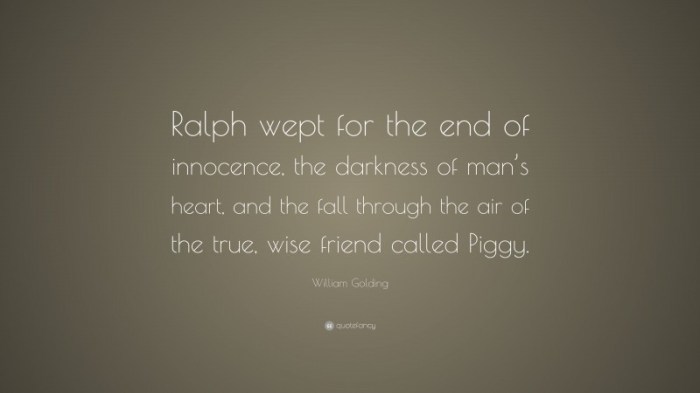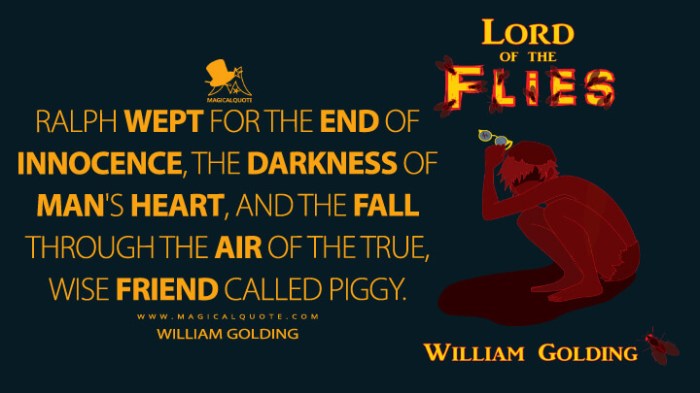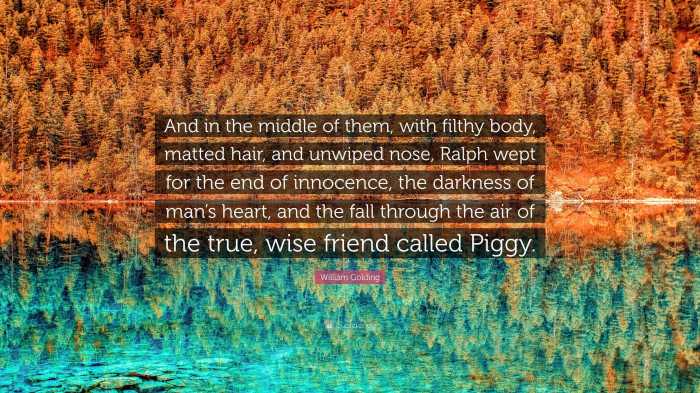Ralph wept for the end of innocence – In William Golding’s seminal novel, “Lord of the Flies,” Ralph’s emotional breakdown symbolizes the profound loss of innocence that permeates the narrative. This essay will delve into the significance of Ralph’s tears, examining the specific events that trigger his emotional collapse and analyzing the psychological impact of witnessing the destruction of innocence on his character.
Furthermore, we will explore the broader themes of morality and the human condition that are laid bare through the loss of innocence, examining the ways in which societal structures and rules contribute to this erosion. By analyzing key symbols and motifs, as well as the author’s use of literary devices, this essay will provide a comprehensive understanding of the theme of innocence lost in “Lord of the Flies.”
Ralph’s Emotional Response

Ralph’s tears serve as a profound symbol of innocence lost, marking a pivotal moment in the novel where the idyllic world of childhood is shattered by the harsh realities of human nature. The specific events that trigger Ralph’s emotional breakdown include the death of Piggy, the destruction of the conch, and the realization that Simon’s murder was a savage act committed by his fellow boys.
Psychological Impact on Ralph
Witnessing the destruction of innocence has a profound psychological impact on Ralph. He is forced to confront the darkness within human nature and the fragility of civilization. His tears represent a loss of faith in the goodness of humanity and a realization of the true extent of human savagery.
The experience leaves Ralph deeply traumatized, forever altering his perspective on life and the world.
The Loss of Innocence in the Novel: Ralph Wept For The End Of Innocence

In William Golding’s Lord of the Flies, the loss of innocence is a central theme that pervades the narrative. The boys stranded on the island are initially innocent and naive, but as the story progresses, they gradually lose their innocence through exposure to violence, savagery, and the harsh realities of life.
The Erosion of Innocence
The erosion of innocence is depicted in the novel through several key scenes and events:
- The killing of Simon: Simon is a gentle and innocent boy who represents the last vestiges of civilization on the island. His murder at the hands of the other boys marks a turning point in the novel, as it signifies the complete loss of innocence and the triumph of savagery.
- The formation of the two tribes: The boys initially divide into two tribes, the “biguns” and the “littluns.” As the tribes become more entrenched, they begin to engage in warfare and violence, further eroding their innocence.
- The hunt for Ralph: Ralph, the elected leader of the boys, represents order and civilization. His relentless pursuit by Jack and his followers symbolizes the final destruction of innocence and the triumph of savagery.
Themes of Morality and the Human Condition
The loss of innocence in Lord of the Fliesexplores broader themes of morality and the human condition:
- The inherent savagery of humanity: The novel suggests that humans are inherently savage and that civilization is a thin veneer that can easily be stripped away. The boys’ descent into savagery on the island demonstrates the fragility of human morality.
- The importance of order and leadership: The absence of adult supervision and the lack of clear leadership on the island lead to chaos and violence. The novel highlights the importance of order and leadership in maintaining a civilized society.
- The search for meaning and purpose: The boys’ experiences on the island force them to confront the harsh realities of life and to search for meaning and purpose in a world that is often cruel and unjust.
The Role of Society in the Destruction of Innocence

The societal structures and rules in Lord of the Fliesplay a significant role in the loss of innocence among the boys. The lack of adult supervision and the absence of any clear moral guidelines create an environment where the boys are free to indulge in their darker impulses.
The rules that are established by the boys themselves are often arbitrary and unjust, and they serve only to further divide and isolate them.
The Role of the Adults
The adults in the novel are conspicuously absent, and their absence is a major factor in the boys’ loss of innocence. Without any adult guidance, the boys are left to their own devices, and they quickly descend into savagery. The adults’ absence also symbolizes the failure of society to protect its children from harm.
The Impact of the War, Ralph wept for the end of innocence
The war that is raging in the outside world also has a profound impact on the boys’ moral development. The boys are constantly exposed to violence and death, and this exposure desensitizes them to suffering. The war also creates a sense of fear and uncertainty, which makes the boys more likely to act out in aggressive ways.
Symbolism and Motifs

The novel Lord of the Fliesemploys various symbols and motifs to convey the theme of innocence lost. These symbols and motifs reinforce the idea that innocence is fragile and easily corrupted.
The Conch
The conch shell represents civilization and order. Its destruction symbolizes the loss of innocence and the descent into savagery.
The Fire
The fire represents both the potential for good and evil. Initially, it is used to signal for help and provide warmth. However, it later becomes a destructive force, symbolizing the destructive nature of unchecked human impulses.
The Island
The island itself is a symbol of both paradise and danger. Initially, it represents a place of escape and freedom. However, as the boys’ behavior deteriorates, it becomes a place of fear and violence, symbolizing the loss of innocence and the dangers of unchecked human nature.
Foreshadowing and Irony
The novel uses foreshadowing and irony to convey the theme of innocence lost. For example, the opening chapter foreshadows the boys’ descent into savagery with the description of the island as a “dark, tangled jungle.” The irony of the boys’ belief that they can create a utopian society on the island highlights the fragility of innocence and the inevitability of human nature’s darker impulses.
Literary Devices

The novel Ralph Wept for the End of Innocenceemploys a range of literary devices to convey the theme of innocence lost. These devices, including foreshadowing, irony, and symbolism, effectively enhance the reader’s understanding of the narrative and its central message.
Foreshadowing
Golding uses foreshadowing to hint at the tragic events that will befall the boys on the island. For instance, the opening description of the island as a “garden” suggests a place of tranquility, but the presence of a “snake-like” coil of creeper foreshadows the impending danger and corruption that will corrupt the boys’ paradise.
Irony
Irony is used throughout the novel to highlight the contrast between the boys’ initial innocence and their subsequent descent into savagery. For example, the choirboys, who initially represent order and civilization, become some of the most brutal and violent members of the tribe.
Symbolism
Golding employs a rich array of symbols to convey the theme of innocence lost. The island itself symbolizes both the potential for paradise and the inherent darkness within human nature. The conch, which initially represents order and democracy, becomes a symbol of the boys’ failed attempt to maintain civilization.
Helpful Answers
What is the significance of Ralph’s tears?
Ralph’s tears symbolize the loss of innocence and the realization of the harsh realities of life.
How does society contribute to the loss of innocence?
Societal structures and rules, such as the emphasis on competition and power, can erode innocence and encourage individuals to abandon moral principles.
What is the role of symbolism in conveying the theme of innocence lost?
Symbols such as the conch, the fire, and the island itself represent the fragile nature of innocence and its destruction.